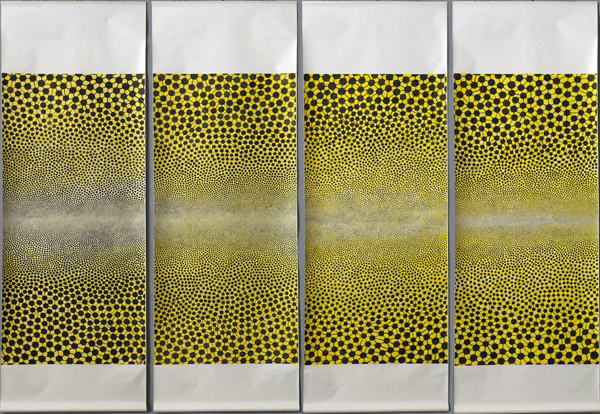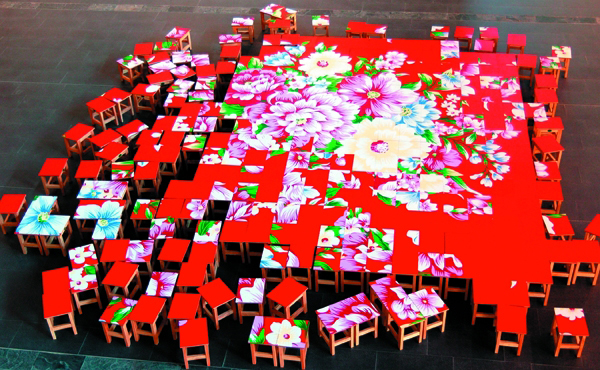In her debut review as an Art Life regular, Luise Guest encounters a sense of melancholy at White Rabbit’s latest exhibition…
As a small child I genuinely believed that if I dug a really, really deep hole I could emerge in China. And last week I did just that, although without any actual digging, by seeing the new show, ‘Down the Rabbit Hole’, at the White Rabbit Gallery. Returning for a second and then a third time to revisit the works and think more closely about my responses, I wondered why this show seemed to be exuding an overwhelming (although not unpleasant) atmosphere of melancholy. On the surface it would seem to be a far more cheerful show than the last, which after all included life-size sculptures of the inhabitants of a Chinese psychiatric hospital, confronting photographs of chained prisoners on the Burmese border, and hanging decapitated bodies reminiscent of Goya. And yet, as I wandered through the 4 floors of the exhibition, pondering over some of the curatorial choices, I found that the themes which emerge present a far from optimistic vision of China today.
Zhou Yunxia, ‘Mystery Asking Heaven’ 2003 – 2006, ink on rice paper, image reproduced courtesy of White Rabbit Gallery
Interestingly, the exceptions to this are the works from Taiwan, which include two beautiful installations by the Luxury Logico artist collective. In particular, the ghostly neon tubes of ‘Scripting’, which sway, rising and falling with the patterns of the music, provide an ethereal and meditative experience. The somnambulist feel of this work is echoed by the time-lapse photographs of moonlit sky over rooftops by Liao Yuan (from Hangzhou) in her ‘Insomnia Series’. The darkened skies include the reflection of a solitary neon tube in each photograph, evoking a most powerful sense of sleeplessness in the middle of the night. She references the words of classical poet Su Shi: “Why does the moon go on shining/Even when people are apart?”
Tokyo born Michael Lin’s work on the top floor, ‘Untitled Gathering’, while not as powerful and dramatically engaging as his larger installations in extraordinary venues such as the Venice and Istanbul Biennales, or even the Queensland Art Gallery at the Asia Pacific Triennial, nevertheless continues his practice of creating transformed spaces in galleries and museums. These spaces become places of public discourse where audiences can experience a joyful interaction with and within the artwork. He has often been described as an artist who has moved beyond the idea of artwork as object, and who challenges our notions of public versus private, modernity and tradition. It has been said (most recently in e-flux) that his works are like gestures of hospitality which embrace the visitor as a guest. This is certainly true of this work, made up of tiny wooden stools like those in street-side restaurants or makeshift village cinemas in Asia, all of which are covered with his characteristic brightly patterned floral fabric designs, like the traditional bed linen of his childhood memories. To me this engaging work suggested a kindergarten (evoking memories of parent teacher meetings with large adults seated on incongruously tiny chairs) partly due to their size and to the jigsaw puzzle element of the piece. I had to resist the urge to rearrange them and make the design whole.
Michael Lin, ‘Untitled Gathering’, 2008, emulsion on wood stools, 320 pieces, image reproduced courtesy of White Rabbit Gallery
Other works, however, bring darker themes to mind, even though many of them are also intended to be humorous. One would have to live under a rock to be unaware of the discussions both within and outside China about the effects of widespread corruption and the often disastrous results of fast paced change, economic growth and rapid industrialisation. Many of the works in this show reveal levels of anxiety and unease about the changes which have taken place in China in the last twenty years. From the obsession with brand names and designer status symbols, to the loss of traditional communities and neighbourhoods, to the prevalence of pollution and anxieties about food safety; all these issues can be read as a kind of subtext in many works –a kind of white noise humming away at the edge of consciousness.
The material practices that many of the artists are employing, however, hark back to scholarly traditions of ink painting and to folk art traditions such as paper-cutting, weaving and quilting. Han Wuzhou’s plaited circle of plastic bags refers most obviously to the ubiquitous presence of discarded shopping bags in Chinese city streets – they are everywhere. However it is also intended to reference notions of infinity, and the plaiting refers to the traditional pigtail imposed on the Han Chinese by Manchu rule which became so iconic an image of Chinese identity. Chen Chun- Hao’s “Imitating Fan Kuan’s ‘Travelled Among Mountain and Streams’ from the Song Dynasty” appears at first to be a lyrical, misty landscape painted in ink. On closer inspection, however, one sees it is made entirely with headless steel pins punched through the work with a nail gun – 750,000 of them. Beauty and tranquillity on the surface, but with an underlying reminder of mechanical ‘fakery’. In Chinese tradition, the copying of historical paintings is an act required of the scholar. This artist, however, reinvents and subverts the act in a similar manner to Xu Bing’s ‘Background Story’ series, where apparent ink paintings are created with rubbish and debris, backlit behind a screen. Another artist working in a similar vein is Yao Lu, whose work was shown in Hong Kong last year in ‘Capturing Cathay’ at Galeries du Monde. What appear to be traditional and beautiful Chinese landscapes prove, on closer viewing, to be made of refuse, plastic garbage bags and all the detritus of growing cities and a fast-paced throw-away materialist culture.
Other interesting works include Zhou Yunxia’s imperial-yellow hanging scrolls based on toad-skins (which the artist had seen discarded in the food markets of Shanghai) with patterns which evoke an intricate web of connections – between people, between past and present, between China and the West. Reminiscent of Yayoi Kusama, they appear to ripple gently as if alive. Wu Jian’an uses paper-cutting in “Gazing at the Moon” and “Fused in Desire”. However these are no traditional ‘double happiness’ patterns but rather a seething mass of thickly piled brightly coloured papercuts depicting characters from ancient myths. It is only on a very close inspection of the work that their complexity is apparent. Like shadow puppets in their sinuous elegance, all pointed fingers and writhing limbs, they become more disturbing the more one looks. In this they reminded me of the work of fellow Beijing artist (also in the collection, but not in this show) Wu Junyong. Wu transforms his papercuts into digital animations, in which tiny puppet-like men and hybrid beasts and insects are manipulated into grotesque parodies of social rituals. Both artists have created a visual language which melds western fairy tales and fables with Chinese mythology, ghost stories, Tibetan temple carvings and tangka scrolls, and sometimes in Wu Junyong’s work with darker visions emanating from the nightmare of the Cultural Revolution.
Finally, the work that for me provided the most compelling reason to go back again – and again – to see this show: Wu Daxin’s “Ashley’s Heart”. A large sculpture of bronze tubes, powered by a fridge compressor, and suggestive of the bare branches of a winter tree, is gradually frozen over the course of the day as humidity from the surrounding air becomes ice forming on the tubes. It drips gently into its clear Perspex base, transforming itself anew each day. The work was inspired by the serious illness of the artist’s friend, Australian critic Ashley Crawford, whom he visited in a Hong Kong hospital, hooked up to tubes and ventilators. At once beautiful and sad, it evokes both the vulnerability and the strength of living beings. The shadow cast by the sculpture on the wall is reminiscent of the brush-marks of Chinese calligraphy, and provides another link between past and present. There is an underlying message of hope and resilience, albeit fragile.
What unites these very different works is a sense of artists struggling to make sense of a world both wondrous and appalling – not so very different in that respect from the one that Alice tumbled into.
Luise Guest blog: www.anartteacherinchina.blogspot.com



Thanks for this review of the current White Rabbit show and hope you have another great visit to China.